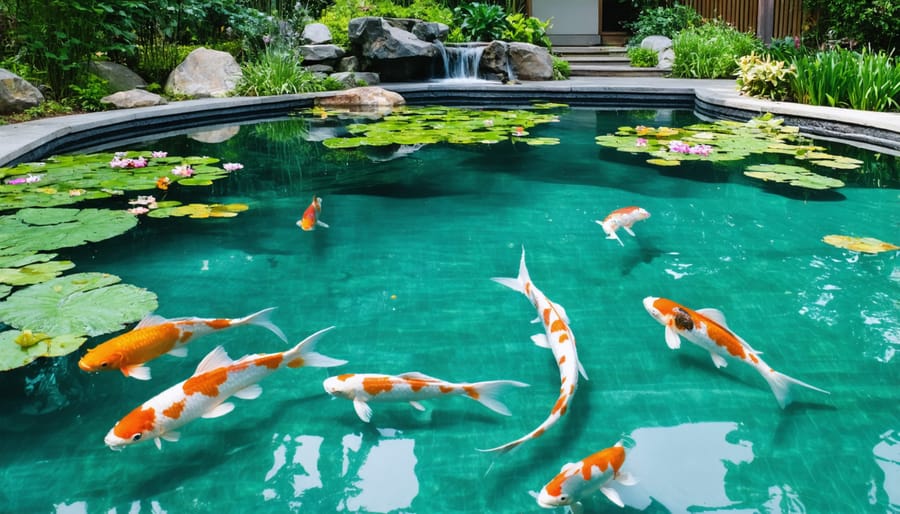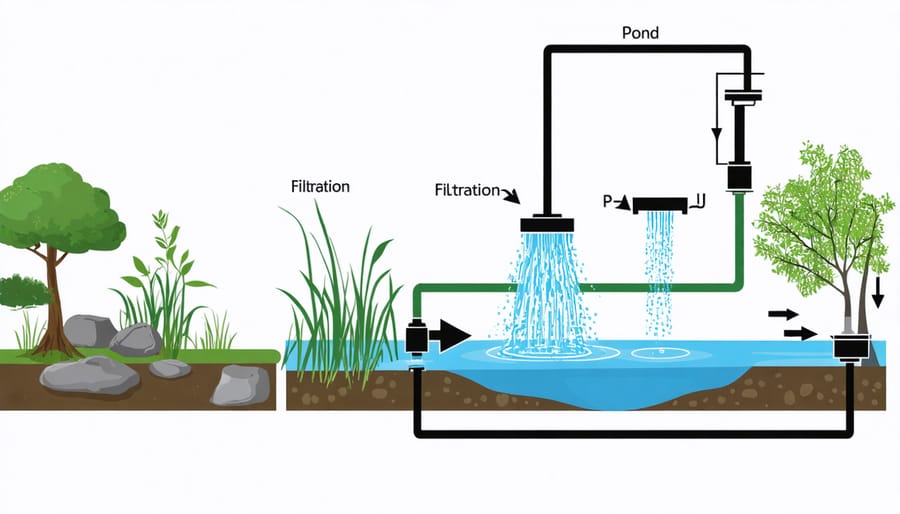
7 Secrets to Creating a Thriving Backyard Pond Ecosystem
Design your pond’s shape, size and location to create a serene oasis that complements your landscape. Consider small pond ideas for intimate spaces. Select appropriate liner material and filtration system to maintain crystal-clear water. Incorporate diverse aquatic plants, from submerged oxygenators to floating lilies, to establish a balanced ecosystem. Introduce fish and beneficial microorganisms gradually to avoid overwhelming the delicate biological equilibrium.
Designing Your Pond

Choosing the Right Location
When selecting the perfect spot for your backyard pond, consider sun exposure, proximity to your house, and integration with the existing landscape. Ideally, choose a location that receives at least 6 hours of direct sunlight daily to support aquatic plants and keep the water warm. However, some shade is beneficial to prevent excessive algae growth. Position the pond close enough to your home for easy access and enjoyment, but far enough to avoid runoff from roofs or gutters. Lastly, think about how the pond will fit into your yard’s layout and design. Use natural contours, existing features like rocks or trees, and complementary landscaping to create a seamless, visually appealing integration.
Determining Pond Size and Depth
Size is a crucial factor in maintaining a healthy backyard pond ecosystem. Larger ponds are generally more stable and easier to balance, as they have greater water volume and surface area. For optimal results, aim for a pond that’s at least 500 gallons (about 6 by 8 feet) and 2 feet deep. This depth provides a cooler bottom layer where fish can retreat in hot weather. However, even smaller ponds around 3 by 4 feet can thrive with proper care. Consider your available space, desired features, and maintenance capacity when determining the ideal size for your backyard oasis.
Pond Lining Options
When selecting a liner for your backyard pond, you have several options. EPDM rubber and PVC are popular choices, offering durability and flexibility. EPDM is more UV-resistant and longer-lasting, while PVC is budget-friendly. Clay liners provide a natural look but require careful installation. Preformed plastic liners are easy to install but limit design flexibility. Proper liner installation is crucial for preventing leaks and ensuring your pond’s longevity. Carefully prepare the pond bed, remove sharp objects, and secure the liner with heavy rocks or edging. Investing time in proper installation will reward you with a beautiful, functional pond for years to come.
Creating Planting Shelves
Planting shelves create a tiered ecosystem within your backyard pond, providing beneficial surfaces for aquatic plants to thrive while offering hiding spots and shade for fish. Shelves at varying depths accommodate different plant species and their lighting needs. When constructing shelves, use sturdy materials like bricks, stones, or prefabricated plastic. Ensure the shelves are level and securely placed to prevent collapse. Aim for shelf depths ranging from a few inches to a foot or more to support diverse plant life. With well-designed planting shelves, you’ll enhance the beauty and functionality of your pond ecosystem, creating a harmonious balance between flora and fauna.
Essential Pond Components

Pump and Filtration Systems
To ensure a healthy and clear pond, selecting the right pump and filtration system is crucial. When sizing a pump, consider the pond’s volume and desired turnover rate. For optimal water quality, aim for a turnover of at least once every two hours. The three main types of pond filters are mechanical (removes debris), biological (breaks down waste), and UV clarifiers (controls algae). A recommended setup includes a skimmer for surface debris, a pump to circulate water, and a biological filter to house beneficial bacteria. Position the pump at the pond’s bottom, connected to the filter, and return the filtered water via a waterfall or stream for aeration. Regular maintenance, such as cleaning the pump and filter media, will keep your system running efficiently and your pond water crystal clear.
Pond Aeration
Pond aeration is essential for maintaining a healthy and vibrant backyard pond ecosystem. By introducing oxygen into the water, aeration helps break down organic matter, reduces algae growth, and supports beneficial bacteria. Air pumps are the most common method of aeration, with options ranging from simple air stones to more advanced diffuser systems. When selecting an air pump, consider the size of your pond and the desired level of aeration. Installation typically involves placing the air pump near the pond, running tubing from the pump to the diffuser, and positioning the diffuser at the bottom of the pond. For optimal results, run the aeration system continuously, especially during warmer months when oxygen levels tend to be lower. With proper aeration, you’ll enjoy a clearer, healthier pond that supports a thriving ecosystem of plants, fish, and other aquatic life.
Stocking Your Pond

Choosing the Right Fish
When selecting fish for your backyard pond, consider species that are well-suited to outdoor living and can thrive in the ecosystem you’ve created. Goldfish, koi, and mosquitofish are popular choices that add beauty and help maintain balance. Goldfish are hardy, colorful, and available in various sizes. Koi are larger, more striking, and can live for decades with proper care. Mosquitofish are small but efficient at controlling mosquito larvae. Avoid overcrowding your pond; a general rule is one inch of fish per square foot of water surface. This ensures adequate space, oxygen, and food for all inhabitants. Consider your pond’s size, depth, and filtration when determining the number and type of fish to introduce. Remember, a well-balanced pond ecosystem relies on the harmonious interaction of fish, plants, and beneficial bacteria, so choose your finned friends wisely to create a thriving aquatic oasis in your backyard.
Aquatic Plant Selection
When selecting aquatic plants for your backyard pond, consider their roles in creating a balanced ecosystem. Marginal plants like cattails and rushes grow along the edges, filtering water and providing shelter for wildlife. Floating plants such as water lilies and lotus add beauty while shading the pond and minimizing algae growth. Submerged plants, including hornwort and anacharis, oxygenate the water and absorb excess nutrients. To establish your aquatic garden, choose a mix of pond plants suited to your climate and pond size. Plant marginal varieties in shallow baskets or shelves, anchor floating plants to the bottom, and weigh down submerged plants or let them drift freely. With proper selection and placement, your pond plants will create a thriving, visually stunning ecosystem that attracts diverse wildlife and enhances your backyard oasis.
Beneficial Bacteria and Insects
Beneficial bacteria and insects play a vital role in maintaining a healthy pond ecosystem. These tiny organisms break down organic matter, control algae growth, and keep the water clean. Bacteria naturally colonize the pond, but you can supplement with commercial bacterial additives to jump-start the process. Insects like dragonflies, damselflies, and water striders prey on mosquitoes and other pests, helping to keep the population in check. Encourage beneficial insects by planting a variety of aquatic plants and avoiding harsh chemicals. A diverse community of microorganisms and insects is essential for a thriving, self-sustaining backyard pond.
Maintaining a Balanced Ecosystem
Water Quality Monitoring
Monitoring your pond’s water quality is essential for a thriving ecosystem. Key parameters to test include pH (ideal range 6.5-8.5), ammonia (below 0.02 ppm), nitrite (below 0.2 ppm), and dissolved oxygen (above 5 ppm). Use a reliable test kit to check these levels regularly. If any are off, take corrective action promptly. For high pH, perform a partial water change or add peat moss. Low pH can be raised with baking soda or crushed coral. Remove excess fish, plants, or debris to reduce ammonia and nitrite. Improve aeration with a fountain or waterfall to boost oxygen levels. Consistent water quality monitoring and quick adjustments will keep your pond ecosystem balanced and thriving.
Regular Cleaning and Maintenance
To keep your backyard pond ecosystem thriving, regular cleaning and maintenance are essential. Skim debris like fallen leaves and twigs from the surface daily using a pond net to prevent organic buildup. Clean or replace filters according to manufacturer instructions to ensure optimal water circulation and clarity. In spring, remove any accumulated debris from the bottom and perform a partial water change. During fall, net out leaves and trim back dying aquatic plants. In colder months, keep a portion of the pond surface ice-free to allow gas exchange. Annually, inspect and clean the pump, check for leaks, and assess the overall health of your pond ecosystem. With consistent care and attention, your backyard oasis will continue to flourish and provide enjoyment for years to come.
Troubleshooting Common Issues
To keep your backyard pond ecosystem thriving, be prepared to tackle common issues. For algae control, maintain proper nutrient balance and introduce beneficial plants like water lettuce or barley straw. Regularly monitor fish health, watching for signs of stress or disease. Quarantine new fish and provide a varied diet. Address plant problems promptly, removing dead or dying foliage and ensuring adequate light and nutrients. If you suspect a leak, first check the water level and inspect liner seams. Temporary patches can be made with aquarium-safe silicone or rubber sealant, but extensive damage may require professional repair or liner replacement. With vigilant observation and swift action, you can overcome challenges and enjoy a beautiful, balanced pond.
Conclusion
By implementing the 7 secrets of a thriving backyard pond ecosystem, you’ll create a captivating oasis that brings beauty, tranquility, and natural wonder to your outdoor space. From thoughtful planning and design to selecting the right plants, fish, and equipment, each step contributes to a harmonious and self-sustaining environment. Regular maintenance, such as cleaning filters, monitoring water quality, and managing plant growth, ensures your pond remains healthy and vibrant. As you witness the ecosystem flourish, with crystal-clear water, lush greenery, and diverse wildlife, you’ll experience the immense satisfaction of nurturing a miniature world in your own backyard. Embrace the journey of creating and caring for your pond, and enjoy the endless rewards it brings. Start your backyard pond adventure today and discover the joy of cultivating a slice of nature right at your doorstep.
